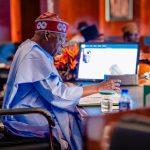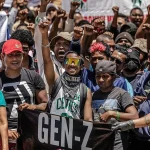By Zainab Ibrahim
A fresh stitch is weaving its way through Nigerian fashion not threads of cloth, but threads of code, imagination, and possibility. Artificial Intelligence (AI) hasn’t taken over the designs yet, but it’s beginning to shape how designers work, dream, and define beauty.
What we already see, from Lagos, Abuja, Port Harcourt, and beyond, is that designers and creatives are pushing boundaries. They are exploring ways to reduce waste, speed up design, experiment with bold ideas in ways that hint at how AI could be their next creative partner.

A New Kind of Muse
In Lagos, a city where style walks with swagger and traffic, a new generation of fashion-tech startups is turning problems into possibilities. Fitted, a tailoring platform founded by Ibi Cookey, uses machine learning to streamline bespoke fashion. It automatically records client measurements, tracks orders, manages logistics making traditional tailoring scalable. What was once chaotic is now a clean, data-powered process.
Another disruptor, Vazzel, is tackling one of the industry’s oldest headaches: sizing. Their AI engine can read body proportions from photos, offering hyper-accurate fit recommendations, especially vital in e-commerce, where returns bleed profit.
“The goal,” co-founder Mayowa Akande says, “is to build a fashion ecosystem where tech meets tradition. Where people don’t have to choose between their culture and the future.”
Digital Design is Here, Just Not Always Seen
You may not see the tech at first glance, but it’s there in the speed, the accuracy, the boldness of today’s Nigerian fashion. Take Veekee James, known for sculpted corsetry and red-carpet dominance. She hasn’t (yet) declared AI part of her toolkit but her design process reflects the very spirit of AI-assisted idea. She once revealed that Osas Ighodaro’s iconic AMVCA dress came after countless iterations. She designed, scrapped, redesigned. That kind of trial-and-error, where imagination refines itself into form, is where AI thrives not by replacing the vision, but accelerating its evolution.
Toyin Lawani of Tiannah’s Empire echoes a similar ethos. For years, she’s blended fashion with theater, technology, and raw provocation. Her designs are rarely subtle, they speak loud, take up space, challenge taste. Though she hasn’t explicitly credited AI, her work lives at the intersection where art meets algorithm: concept pieces that would benefit immensely from virtual simulations, 3D visualizations, and AI-aided material testing. They and many like them are walking toward the digital, even if they don’t call it AI yet.
AI as a Cultural Canvas
But perhaps the most poetic use of AI in Nigerian fashion comes not from a designer, but from a digital artist: Malik Afegbua.
His “Elders Series,” created with AI platforms like Midjourney, reimagines older Nigerians walking futuristic runways in regal, Afrocentric garments. The images aren’t real but they feel like they should be.
Afegbua says the project was born from grief when his mother fell ill, and he began imagining a happier space for her in his mind. AI became his brush.
“I wanted to create joy,” he says. “To show that age is not a barrier to beauty.”
His work went viral globally. It proved that AI isn’t just a tool of commerce. It can be a vessel for culture, memory, and emotion as well as a platform for representation long denied in traditional media.
The Risk and the Promise
Of course, the AI needle cuts both ways. There are concerns: Who owns an AI-generated design? If a tool is trained on millions of images some by African designers, some not does it steal? Does it flatten creativity into trend? What happens to the artisan when the algorithm becomes the assistant?
But there’s also promise. AI can lower the barrier to entry. With free tools, a young designer in Aba or Jos can visualize a full collection without sewing a single sample. They can test colors, mix textiles, simulate drape and fall all on a screen. That’s not cheating. That’s survival in a fast-moving industry.
The Road Ahead
Nigeria’s fashion ecosystem doesn’t need to “catch up.” It needs to lead differently.
Where the West has tech giants, Nigeria has cultural currency. Our designers don’t just create clothes, they create stories, statements, symbols. AI can’t teach that. But it can scale it.
Imagine a Veekee James lookbook where fans globally try on digital outfits via AR filters. Imagine Tiana’s next avant-garde collection previewed as a virtual runway in the metaverse. Imagine apprentices in Surulere learning design through AI tutorials in Yoruba.
These are not far-fetched dreams. The code exists. The creativity is already here. What’s missing is access, support, and intentional adoption.








